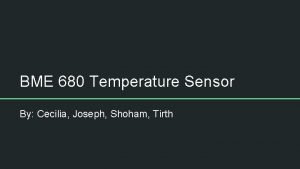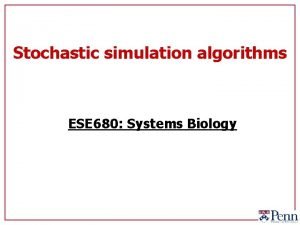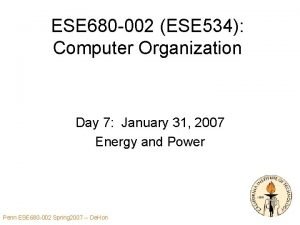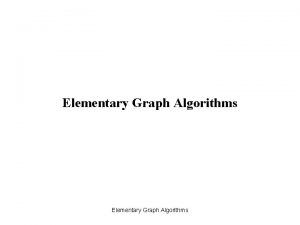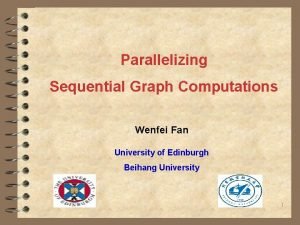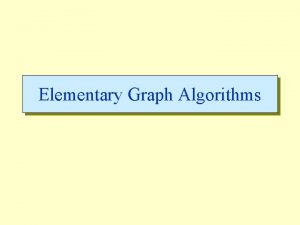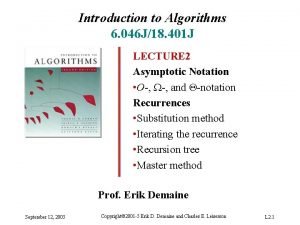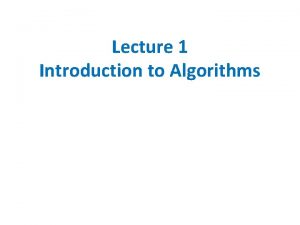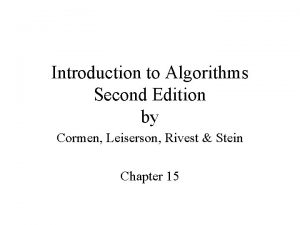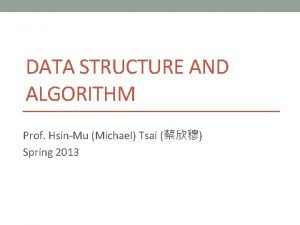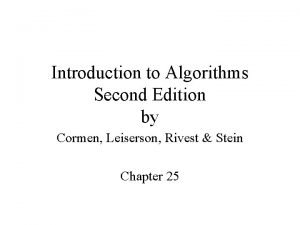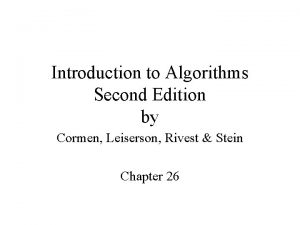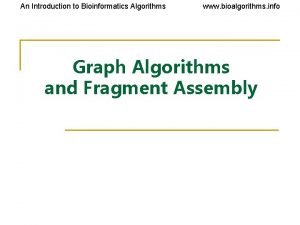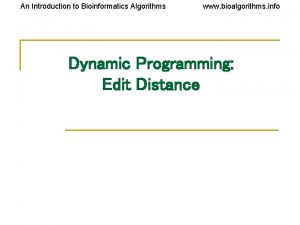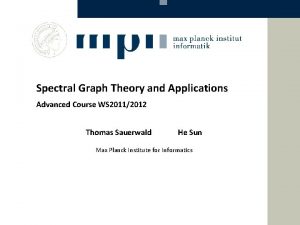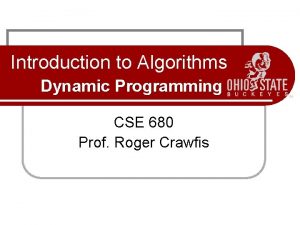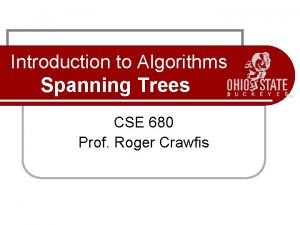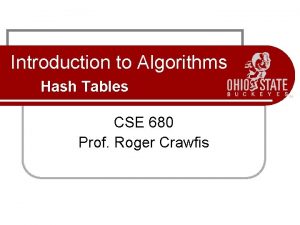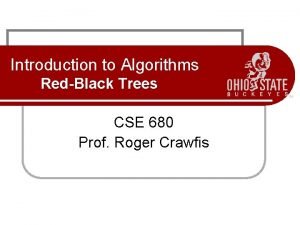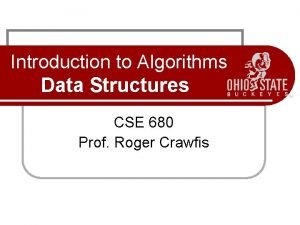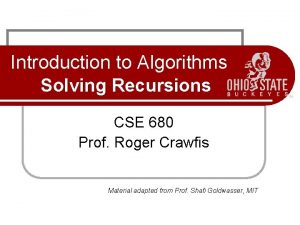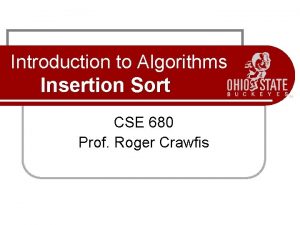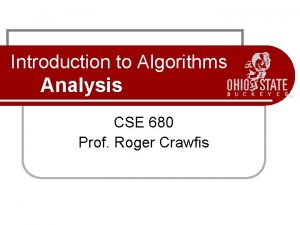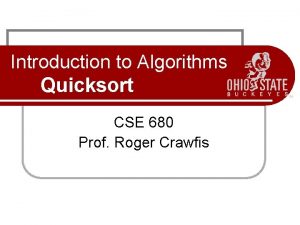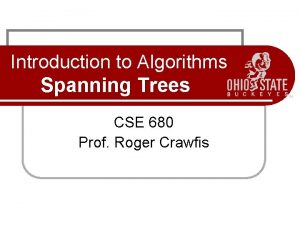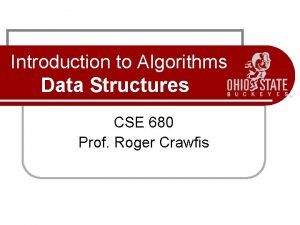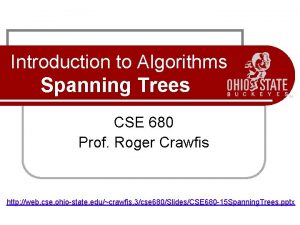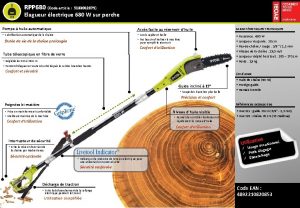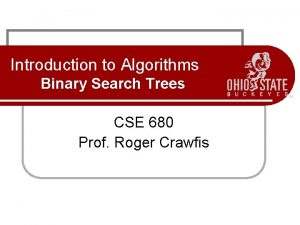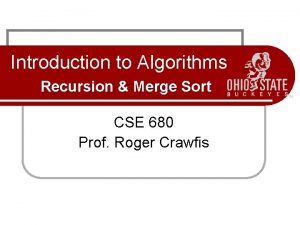Introduction to Algorithms Graph Algorithms CSE 680 Prof



















![Correctness Proof l l Show if (u, v) E, then f [v] < f Correctness Proof l l Show if (u, v) E, then f [v] < f](https://slidetodoc.com/presentation_image_h2/03cde3af0a778bf9a78231d5b251af7a/image-20.jpg)












- Slides: 32

Introduction to Algorithms Graph Algorithms CSE 680 Prof. Roger Crawfis

Bipartiteness Graph G = (V, E) is bipartite iff it can be partitioned into two sets of nodes A and B such that each edge has one end in A and the other end in B Alternatively: • Graph G = (V, E) is bipartite iff all its cycles have even length • Graph G = (V, E) is bipartite iff nodes can be coloured using two colours Question: given a graph G, how to test if the graph is bipartite? Note: graphs without cycles (trees) are bipartite: non bipartite

Testing bipartiteness Method: use BFS search tree Recall: BFS is a rooted spanning tree. Algorithm: • Run BFS search and colour all nodes in odd layers red, others blue • Go through all edges in adjacency list and check if each of them has two different colours at its ends - if so then G is bipartite, otherwise it is not We use the following alternative definitions in the analysis: • Graph G = (V, E) is bipartite iff all its cycles have even length, or • Graph G = (V, E) is bipartite iff it has no odd cycle non bipartite

Topological Sort Want to “sort” or linearize a directed acyclic graph (DAG). A B E C A B D C D E

Topological Sort Performed on a DAG. l Linear ordering of the vertices of G such that if (u, v) E, then u appears before v. l Topological-Sort (G) 1. call DFS(G) to compute finishing times f [v] for all v V 2. as each vertex is finished, insert it onto the front of a linked list 3. return the linked list of vertices Time: (V + E).

Example A B D 1/ C E Linked List:

Example A B D 1/ 2/ C E Linked List:

Example A B D 1/ 2/3 C E Linked List: 2/3 E

Example B A D 1/4 2/3 C E Linked List: 1/4 2/3 D E

Example A B D 5/ 1/4 2/3 C E Linked List: 1/4 2/3 D E

Example A B D 5/ 1/4 6/ 2/3 C E Linked List: 1/4 2/3 D E

Example A B D 5/ 1/4 6/7 2/3 C E Linked List: 6/7 1/4 2/3 C D E

Example B D 5/8 1/4 A 6/7 2/3 C E Linked List: 5/8 6/7 1/4 2/3 B C D E

Example A B D 9/ 5/8 1/4 6/7 2/3 C E Linked List: 5/8 6/7 1/4 2/3 B C D E

Example A B D 9/10 5/8 1/4 6/7 2/3 C E Linked List: 9/10 5/8 6/7 1/4 2/3 A B C D E

Precedence Example l Tasks that have to be done to eat breakfast: l get glass, pour juice, get bowl, pour cereal, pour milk, get spoon, eat. l Certain events must happen in a certain order (ex: get bowl before pouring milk) l For other events, it doesn't matter (ex: get bowl and get spoon)

Precedence Example get glass pour juice get bowl pour cereal pour milk eat breakfast Order: glass, juice, bowl, cereal, milk, spoon, eat. get spoon

Precedence Example l Topological 1 2 3 4 eat 5 6 Sort 7 8 9 10 milk juice cereal glass bowl consider reverse order of finishing times: spoon, bowl, cereal, milk, glass, juice, eat 11 12 13 14 spoon

Precedence Example l What if we started with juice? 1 4 2 3 eat juice 5 6 glass 7 8 9 10 milk cereal bowl consider reverse order of finishing times: spoon, bowl, cereal, milk, glass, juice, eat 11 12 13 14 spoon
![Correctness Proof l l Show if u v E then f v f Correctness Proof l l Show if (u, v) E, then f [v] < f](https://slidetodoc.com/presentation_image_h2/03cde3af0a778bf9a78231d5b251af7a/image-20.jpg)
Correctness Proof l l Show if (u, v) E, then f [v] < f [u]. When we explore (u, v), what are their colors? l l Note, u is gray – we are exploring it Is v gray? l l Is v white? l l l No, because then v would be an ancestor of u. (u, v) is a back edge. a cycle (dag has no back edges). Then v becomes descendant of u. By parenthesis theorem, d[u] < d[v] < f [u]. Is v black? l l l Then v is already finished. Since we’re exploring (u, v), we have not yet finished u. Therefore, f [v] < f [u].

Strongly Connected Components l Consider a directed graph. l A strongly connected component (SCC) of the graph is a maximal set of nodes with a (directed) path between every pair of nodes. l If a path from u to v exists in the SCC, then a path from v to u also exists. l Problem: Find all the SCCs of the graph.

Uses of SCC’s l Packaging software modules Construct directed graph of which modules call which other modules l A SCC is a set of mutually interacting modules l Pack together those in the same SCC l

SCC Example h f a e g c b d four SCCs

Main Idea of SCC Algorithm l DFS tells us which nodes are reachable from the roots of the individual trees l Also need information in the other direction: is the root reachable from its descendants? l Run DFS again on the transpose graph (reverse the directions of the edges)

SCC Algorithm Input: directed graph G = (V, E) 1. call DFS(G) to compute finishing times 2. compute GT // transpose graph 3. call DFS(GT), considering nodes in decreasing order of finishing times 4. each tree from Step 3 is a separate SCC of G

SCC Algorithm Example h f a e g c b d input graph - run DFS

4 5 c 8 10 11 d 12 13 14 h e b a Order of nodes for Step 3: f, g, h, a, e, b, d, c g f 15 fin(f) 9 fin(g) 7 fin(h) 6 fin(a) 3 fin(e) 2 fin(b) 1 fin(d) fin(c) After Step 1 16

After Step 2 h f a e g c b d transposed input graph - run DFS with specified order of nodes

After Step 3 1 2 3 4 5 6 7 8 9 10 11 12 13 14 15 16 g h f e a SCCs are {f, h, g} and {a, e} and {b, c} and {d}. c b d

Run Time of SCC Algorithm l Step 1: O(V+E) to run DFS l Step 2: O(V+E) to construct transpose graph, assuming adjacency list rep. l Adjacency matrix is O(1) time w/ wrapper. l Step 3: O(V+E) to run DFS again l Step 4: O(V) to output result l Total: O(V+E)

Component Graph l GSCC = (VSCC, ESCC). l VSCC has one vertex for each SCC in G. l ESCC has an edge if there’s an edge between the corresponding SCC’s in G. {a, e} {f, h, g} GSCC based on example graph from before {d} {b, c}

Component Graph Facts l Claim: GSCC is a directed acyclic graph. l l l Suppose there is a cycle in GSCC such that component Ci is reachable from component Cj and vice versa. Then Ci and Cj would not be separate SCCs. Lemma: If there is an edge in GSCC from component C' to component C, then f(C') > f(C). l l l Consider any component C during Step 1 (running DFS on G) Let d(C) be earliest discovery time of any node in C Let f(C) be latest finishing time of any node in C
 Altair 680
Altair 680 Talk 680
Talk 680 F tag 689
F tag 689 Bme 680
Bme 680 Ese 680
Ese 680 Nur 680
Nur 680 Morbidly interesting
Morbidly interesting 260 in word form
260 in word form Ese 680
Ese 680 A 680 newton student runs up a flight of stairs
A 680 newton student runs up a flight of stairs Ese 680
Ese 680 White path theorem
White path theorem Parallelizing sequential graph computations
Parallelizing sequential graph computations W graph
W graph Undirected graph algorithms
Undirected graph algorithms An introduction to the analysis of algorithms
An introduction to the analysis of algorithms Bioinformatics
Bioinformatics Introduction of design and analysis of algorithms
Introduction of design and analysis of algorithms Introduction to algorithms
Introduction to algorithms Introduction to algorithms slides
Introduction to algorithms slides Introduction to algorithms 2nd edition
Introduction to algorithms 2nd edition Introduction to algorithms
Introduction to algorithms Introduction to algorithms lecture notes
Introduction to algorithms lecture notes Introduction to the design and analysis of algorithms
Introduction to the design and analysis of algorithms Introduction to sorting algorithms
Introduction to sorting algorithms Introduction to algorithms 2nd edition
Introduction to algorithms 2nd edition Introduction to algorithms 2nd edition
Introduction to algorithms 2nd edition Introduction to bioinformatics algorithms
Introduction to bioinformatics algorithms An introduction to bioinformatics algorithms
An introduction to bioinformatics algorithms Texte argumentatif développement
Texte argumentatif développement Bridge graph
Bridge graph Wait-for graph
Wait-for graph Spectral graph theory course
Spectral graph theory course



